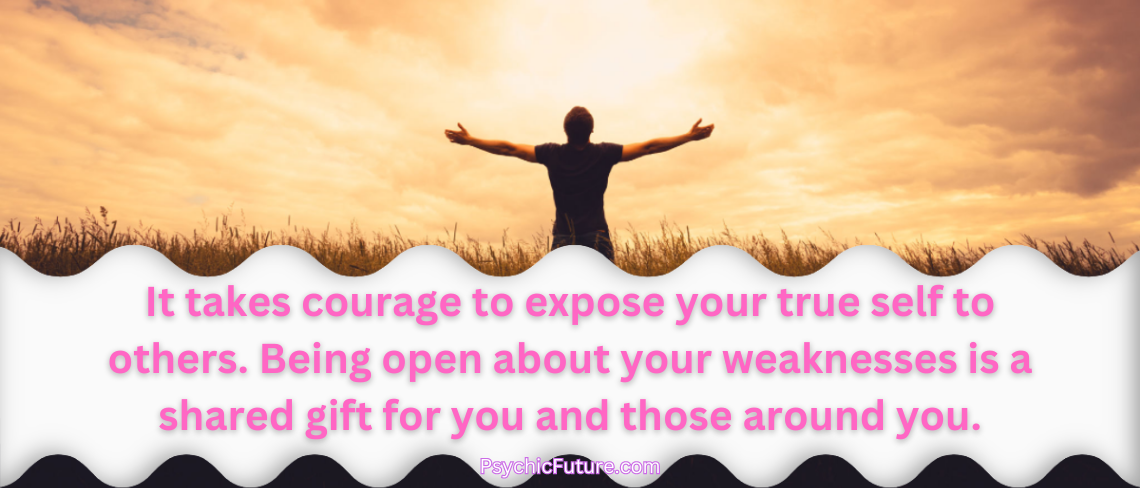Delving into the depth of human emotions and understanding their role in shaping our behaviour is a fascinating journey.
Stating that “It takes courage to expose your true self to others. Being open about your weaknesses is a shared gift for you and those around you” offers a robust starting point for such exploration.
This declaration is an exemplification of two intertwined psychological concepts: courage and vulnerability, both essential elements that fundamentally drive human connections and self-growth.
Firstly, let’s consider that it takes courage to expose our true self to others. Courage, as defined by psychologist Cynthia Pury (2010)*1, is the intentional pursuit of a worthwhile goal or objective despite the presence of risk or adversity. Exposing one’s true self embodies these principles of courage. It involves presenting our authentic self to the world, complete with our strengths, weaknesses, triumphs, and failures—essentially, being fearlessly ourselves.
However, why is it deemed courageous? Because it entails risk—the risk of being judged, misunderstood, or even rejected (Leary, 2005)*2. Such exposure can provoke anxiety and trepidation, as we innately crave acceptance and fear ostracisation. Yet, this courage in authenticity also brings a liberating and empowering perspective. Being genuinely yourself allows you to reject the societal pressure of conforming and gives you the freedom to honour your true feelings, beliefs, and desires (Brown, 2006)*3.
In the realm of psychology, authenticity is closely linked with positive mental health outcomes such as increased self-esteem and reduced anxiety and depression (Wood et al., 2008)*4. Thus, although revealing your true self is risky, the psychological rewards can significantly outweigh the potential negatives.
The second statement—”Being open about your weaknesses is a shared gift for you and those around you”—delicately unravels the concept of vulnerability as a shared gift. Vulnerability is commonly misunderstood as a weakness or something to be ashamed of. However, renowned researcher Brené Brown (2012)*5, in her ground-breaking work, has redefined vulnerability as a strength. She described it as the “willingness to show up and be seen with no guarantee of outcome.”
Being open about our weaknesses, fears, or failures, i.e., being vulnerable, can have profound effects on both ourselves and the people we interact with. When we expose our vulnerabilities, we give others permission to do the same. It fosters an environment of mutual respect, understanding, and empathy (Reis et al., 2004)*6.
Moreover, the process of revealing our weaknesses can foster a deeper connection with others, leading to more satisfying relationships. It promotes understanding and intimacy, contributing to stronger bonds (Kahn & Garrison, 2009)*7. Hence, vulnerability is indeed a shared gift—offering invaluable benefits to ourselves and those around us.
Furthermore, by accepting and acknowledging our vulnerabilities, we embrace our humanity. This acceptance can be an incredibly liberating experience that leads to personal growth and resilience (Brown, 2010)*8. It allows us to embrace a growth mindset, viewing our weaknesses not as static flaws but as areas of potential improvement and development (Dweck, 2006)*9.
Understanding this, how then can we muster the courage to expose our true selves and accept our vulnerabilities? Here are some practical suggestions:
- Practice self-awareness: Regular self-reflection can help identify your strengths, weaknesses, and core values, promoting authenticity (Sutton, 2016)*10.
- Embrace self-compassion: Be kind to yourself when you encounter failures or mistakes. Recognise that everyone is imperfect and that it’s okay to be flawed (Neff, 2003)*11.
- Cultivate empathy: Empathy towards others can help create an environment where vulnerability is encouraged and accepted (Gerdes et al., 2010)*12.
- Engage in mindfulness: Mindfulness allows us to live in the moment, accept our feelings, and lower our defensive barriers (Kabat-Zinn, 2003)*13.
In conclusion, exposing our true selves and acknowledging our vulnerabilities is a courageous act—one that is filled with challenges but also replete with immense rewards. It strengthens our connection with others and contributes to personal growth and self-acceptance. It allows us to embrace our humanity and provides a pathway towards authenticity, fostering a more fulfilling, enriched life.
References:
- Pury, C. (2010). Courage: The Backbone of Leadership. Jossey-Bass.
- Leary, M. R. (2005). Sociometer theory and the pursuit of relational value: Getting to the root of self-esteem. European Review of Social Psychology, 16(1), 75-111.
- Brown, B. (2006). Authenticity: Letting go of what people think. I Thought It Was Just Me (but it isn’t). Gotham.
- Wood, A. M., Linley, P. A., Maltby, J., Baliousis, M., & Joseph, S. (2008). The authentic personality: A theoretical and empirical conceptualisation and the development of the Authenticity Scale. Journal of counseling psychology, 55(3), 385.
- Brown, B. (2012). Daring Greatly. Gotham.
- Reis, H. T., Collins, W. A., & Berscheid, E. (2000). The relationship context of human behavior and development. Psychological bulletin, 126(6), 844.
- Kahn, W. A., & Garrison, L. (2009). Emotional authenticity: a ‘manned’ space? Journal of Organizational Change Management.
- Brown, B. (2010). The Gifts of Imperfection. Hazelden.
- Dweck, C. (2006). Mindset: The New Psychology of Success. Random House.
- Sutton, A. (2016). Measuring the effects of self-awareness: Construction of the Self-Awareness Outcomes Questionnaire. Europe’s Journal of Psychology, 12(4), 645.
- Neff, K. (2003). Self-compassion: An alternative conceptualisation of a healthy attitude toward oneself. Self and Identity, 2(2), 85-101.
- Gerdes, K. E., Lietz, C. A., & Segal, E. A. (2010). Measuring empathy in the 21st century: Development of an empathy index rooted in social cognitive neuroscience and social justice. Social Work Research, 35(2), 83-93.
- Kabat-Zinn, J. (2003). Mindfulness-based interventions in context: Past, present, and future. Clinical psychology: Science and Practice, 10(2), 144-156.



